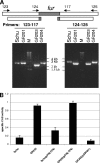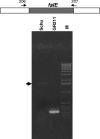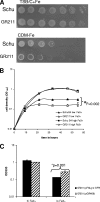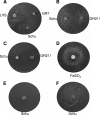fslE is necessary for siderophore-mediated iron acquisition in Francisella tularensis Schu S4
- PMID: 18539739
- PMCID: PMC2493265
- DOI: 10.1128/JB.00181-08
fslE is necessary for siderophore-mediated iron acquisition in Francisella tularensis Schu S4
Abstract
Strains of Francisella tularensis secrete a siderophore in response to iron limitation. Siderophore production is dependent on fslA, the first gene in an operon that appears to encode biosynthetic and export functions for the siderophore. Transcription of the operon is induced under conditions of iron limitation. The fsl genes lie adjacent to the fur homolog on the chromosome, and there is a canonical Fur box sequence in the promoter region of fslA. We generated a Deltafur mutant of the Schu S4 strain of F. tularensis tularensis and determined that siderophore production was now constitutive and no longer regulated by iron levels. Quantitative reverse transcriptase PCR analysis with RNA from Schu S4 and the mutant strain showed that Fur represses transcription of fslA under iron-replete conditions. We determined that fslE (locus FTT0025 in the Schu S4 genome), located downstream of the siderophore biosynthetic genes, is also under Fur regulation and is transcribed as part of the fslABCDEF operon. We generated a defined in-frame deletion of fslE and found that the mutant was defective for growth under iron limitation. Using a plate-based growth assay, we found that the mutant was able to secrete a siderophore but was defective in utilization of the siderophore. FslE belongs to a family of proteins that has no known homologs outside of the Francisella species, and the fslE gene product has been previously localized to the outer membrane of F. tularensis strains. Our data suggest that FslE may function as the siderophore receptor in F. tularensis.
Figures






Similar articles
-
The 58-kilodalton major virulence factor of Francisella tularensis is required for efficient utilization of iron.Infect Immun. 2009 Oct;77(10):4429-36. doi: 10.1128/IAI.00702-09. Epub 2009 Aug 3. Infect Immun. 2009. PMID: 19651867 Free PMC article.
-
The fslE homolog, FTL_0439 (fupA/B), mediates siderophore-dependent iron uptake in Francisella tularensis LVS.Infect Immun. 2010 Oct;78(10):4276-85. doi: 10.1128/IAI.00503-10. Epub 2010 Aug 9. Infect Immun. 2010. PMID: 20696823 Free PMC article.
-
Two parallel pathways for ferric and ferrous iron acquisition support growth and virulence of the intracellular pathogen Francisella tularensis Schu S4.Microbiologyopen. 2016 Jun;5(3):453-68. doi: 10.1002/mbo3.342. Epub 2016 Feb 25. Microbiologyopen. 2016. PMID: 26918301 Free PMC article.
-
Iron and Virulence in Francisella tularensis.Front Cell Infect Microbiol. 2017 Apr 4;7:107. doi: 10.3389/fcimb.2017.00107. eCollection 2017. Front Cell Infect Microbiol. 2017. PMID: 28421167 Free PMC article. Review.
-
Gene regulation of siderophore-mediated iron acquisition in Pseudomonas: not only the Fur repressor.Mol Microbiol. 1995 Aug;17(4):603-10. doi: 10.1111/j.1365-2958.1995.mmi_17040603.x. Mol Microbiol. 1995. PMID: 8801415 Review.
Cited by
-
Genetic diversity within the genus Francisella as revealed by comparative analyses of the genomes of two North American isolates from environmental sources.BMC Genomics. 2012 Aug 24;13:422. doi: 10.1186/1471-2164-13-422. BMC Genomics. 2012. PMID: 22920915 Free PMC article.
-
Subversion of host recognition and defense systems by Francisella spp.Microbiol Mol Biol Rev. 2012 Jun;76(2):383-404. doi: 10.1128/MMBR.05027-11. Microbiol Mol Biol Rev. 2012. PMID: 22688817 Free PMC article. Review.
-
The Multiple Localized Glyceraldehyde-3-Phosphate Dehydrogenase Contributes to the Attenuation of the Francisella tularensis dsbA Deletion Mutant.Front Cell Infect Microbiol. 2017 Dec 11;7:503. doi: 10.3389/fcimb.2017.00503. eCollection 2017. Front Cell Infect Microbiol. 2017. PMID: 29322032 Free PMC article.
-
The 58-kilodalton major virulence factor of Francisella tularensis is required for efficient utilization of iron.Infect Immun. 2009 Oct;77(10):4429-36. doi: 10.1128/IAI.00702-09. Epub 2009 Aug 3. Infect Immun. 2009. PMID: 19651867 Free PMC article.
-
The fslE homolog, FTL_0439 (fupA/B), mediates siderophore-dependent iron uptake in Francisella tularensis LVS.Infect Immun. 2010 Oct;78(10):4276-85. doi: 10.1128/IAI.00503-10. Epub 2010 Aug 9. Infect Immun. 2010. PMID: 20696823 Free PMC article.
References
-
- Baichoo, N., T. Wang, R. Ye, and J. D. Helmann. 2002. Global analysis of the Bacillus subtilis Fur regulon and the iron starvation stimulon. Mol. Microbiol. 451613-1629. - PubMed
-
- Braun, V. 2003. Iron uptake by Escherichia coli. Front. Biosci. 8s1409-s1421. - PubMed
-
- Chakraborty, R., E. Storey, and D. van der Helm. 2007. Molecular mechanism of ferricsiderophore passage through the outer membrane receptor proteins of Escherichia coli. Biometals 20263-274. - PubMed
Publication types
MeSH terms
Substances
Grants and funding
LinkOut - more resources
Full Text Sources
Other Literature Sources
Medical

